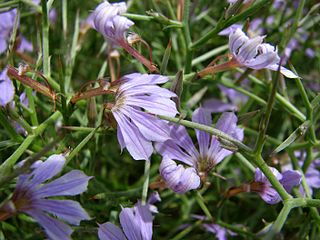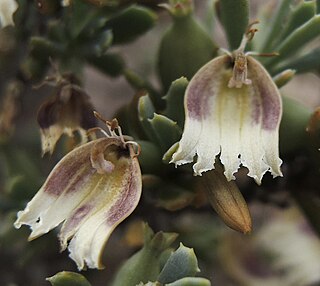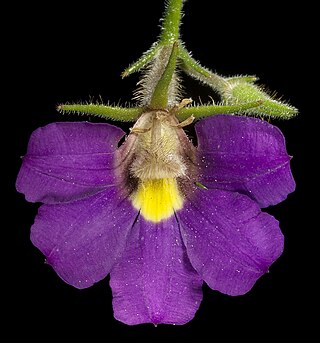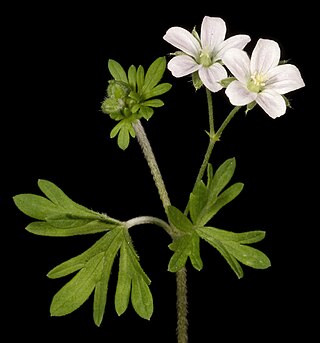
Scaevola is a genus of flowering plants in the Goodenia family, Goodeniaceae. It consists of more than 130 species, with the center of diversity being Australia and Polynesia. There are around 80 species in Australia, occurring throughout the continent, in a variety of habitats. Diversity is highest in the South West, where around 40 species are endemic.

Scaevola crassifolia is a shrub in the family Goodeniaceae, native to Western Australia and South Australia. Common names include cushion fanflower, thick-leaved fanflower and thick-leaved scaevola. It grows up to 1.5 metres high and 3 metres wide and produces white, blue or pale purple flowers from July to February in its native range.
Plantago debilis is a species of herb native to Australia. Common names include shade plantain and weak plantain.

Solanum chippendalei is a small fruiting shrub in the family Solanaceae, native to northern Australia. It is named after its discoverer, George Chippendale. The fruits, known as "bush tomatoes", are edible and are an important indigenous food, and the aborigines who use them broadcast the seed for later harvesting.

Scaevola platyphylla, commonly known as broad-leaved fanflower, is a shrub in the family Goodeniaceae. It is endemic to the south-west of Western Australia. Plants grow to between 0.3 and 1.3 metres high and have blue to purple flowers that appear between August and January in their native range.

Scaevola oxyclona, commonly known as tangled fanflower, is a spiny shrub in the family Goodeniaceae, native to Western Australia. It grows to between 0.1 and 1.5 metres high and produces blue to purple flowers from August to December in its native range. The species was first formally described in 1876 by Victorian Government Botanist Ferdinand von Mueller in the tenth volume of Fragmenta Phytographiae Australiae based on plant material collected at Frasers Range and Mount Benjamin.

Scaevola calendulacea commonly known as dune fan-flower, is a flowering plant in the family Goodeniaceae. It is a small, mat-forming shrub with blue fan-shaped flowers with a yellow centre and grows on sand dunes in eastern and southern Australia.

Chenopodium spinescens is a species of plant in the family Amaranthaceae and is endemic to all mainland states and territories of Australia where it is known as Rhagodia spinescens.

Scaevola argentea, is a low growing, branching shrub in the family Goodeniaceae.

Scaevola acacioides, is an erect, spreading shrub in the family Goodeniaceae.

Scaevola basedowii is an erect multi-stemmed shrub in the family Goodeniaceae, endemic to Western Australia, the Northern Territory and South Australia.

Scaevola browniana is a shrub in the family Goodeniaceae, endemic to Western Australia, the Northern Territory and Queensland.

Scaevola collaris is a shrub in the family Goodeniaceae and its native range is five mainland states/territories of Australia: the Northern Territory, New South Wales, South Australia, Queensland and Western Australia.

Exocarpos aphyllus belongs to the sandalwood plant family (Santalaceae). Noongar names are chuk, chukk, dtulya and merrin. It is a species endemic to Australia.

Scaevola nitida is an erect shrub in the family Goodeniaceae, native to Western Australia. It grows to a height of 0.3 to 3 m, and its blue-purple flowers may be seen from August to December.

Scaevola humifusa is a prostrate shrub in the family Goodeniaceae, native to Western Australia. It grows to a height of 0.01 to 0.5 m, and its white-cream/white-blue flowers may be seen from August to November or January.

Scaevola parvifolia is an erect, many stemmed perennial in the family Goodeniaceae, which is native to Western Australia, the Northern Territory, Queensland and South Australia. It grows to a height of 0.6 m, and its blue-purple flowers may be seen from March to October.

Scaevola phlebopetala, commonly known as velvet fanflower, is a herb in the family Goodeniaceae and is endemic to Western Australia.

Geranium solanderi is a species of plant in the family Geraniaceae. It is native to Australia, and to New Zealand.

Dampiera dentata is a plant in the family Goodeniaceae, native to Western Australia and the Northern Territory.
























